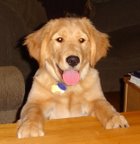For those of you that are parents and have struggled with behavioral issues from time to time, wouldn't you have just loved to be able to call an expert that would come and watch you and your child interact? An expert that would then give you several different suggestions for how to go about making changes to set your child up for success?
I know I would have.
And that's exactly what happened today for Belle and I. Nancy H., Helping Paws Foster Home Coordinator stopped by to observe Belle and I in action and give me some tips and tricks to improve Belle's really reliable recall and other behaviors that are getting in the way of her being the greatest star she can be. What a help!
Step 1: Don't give her the opportunity to "practice" not coming when called. Nancy gave me a great leash for use with this step. It's exceptionally long and Belle will wear it when she's in the yard. She will still feel as if she is free, but she won't be able to run away when I call her because the long trailing leash makes it easier for me to stop her and if necessary, "assist" her in coming to me.
Step 2: Go back to always having her on leash when going outside and continue to work in the yard, with all its inherent distractions, to help her to understand that following cues is required regardless of her location.
Step 3: Greetings. Go back to directing Belle to a specific position (or her crate) when someone comes to the door, or put her gentle leader on. Again, the goal is to prevent the practice of jumping up on people, and to encourage the practice of self-control and calm when greeting. The ultimate goal is to get to the point where people coming and going is just business as usual for Belle.
Step 4: Barking when I go outside her Invisible Fence zone. Nancy suggested that I treat this just like the crate barking. Stay close enough to reinforce her quiet behavior when she's in the crate or in the yard. If she's quiet when I go into the garage - immediately treat and praise her for that behavior.
Nancy also gave me some great tips on eye contact. It's really natural for human trainers to try and maintain eye contact with the dog. The problem with this tendency is that oftne the dog will equate non-eye contact with either a "release" from a given cue or a reason to ignore a spoken cue if it's not paired with the eye contact. Nancy told me about her "eyes in the back of the head" trick. When sitting having morning coffee, she will keep a look out via peripheral vision for when her dog looks at her. As soon as the dog looks, she will click and treat. The key is to find ways to disassociate eye contact with cues for required behaviors.
Time will tell how well I'm able to help Belle "rethink" and reform some of the habits I've unwittingly reinforced. Still, I'm inspired to begin the process because of the great help and support from Nancy.
The Life of a Doting Grandmother
12 years ago





No comments:
Post a Comment